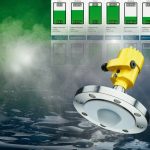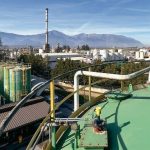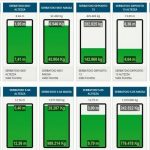Firmen im Artikel
There are companies today who are trendsetters and don’t even know it. Itelyum Spa in Pieve Fissiraga, Italy, for example, has been focusing on circular economy and ecological sustainability for more than half a century already. The company specialises in the treatment of lubricating oils, the purification of solvents and chemical waste, as well as environmental services for industry. In the course of its long history, the company has been constantly developing new processes and technologies in order to produce high-quality lubricant base materials from waste oils. These are then used in various lubricating applications in the automotive sector, as well as in other industries. At least 95 % of the lubricating oil they process is converted into new products or further refined by third parties. Any entrained water is returned to the environment as purified water.
Today, more than 850 employees at 26 production sites serve more than 30 000 customers in more than 60 countries. The company is a leader in the production of regenerated lubricant bases (Regeneration Solutions) and high-purity solvents from by-products generated during manufacturing processes. They are also involved in the purification of chemical waste and used solvents from the chemical and pharmaceutical industries (Purification Solutions). Besides that, the company provides a range of integrated services for producers of hazardous waste. This includes collection, storage, transport, pre-treatment, brokerage, consultancy, chemical analysis and treatment of industrial water.
The plant in Ceccano, in the province of Frosinone, can process up to 84 000 t of used mineral oil per year; in 2021 it processed over 64 000 t. This annual quantity yields around 44 000 t of lubricants, 8000 t of bitumen, 5000 t of diesel oil and 6000 t of purified water. These raw materials, i.e. the intermediate and end-products, are stored in more than 100 tanks.
Four steps to the end product
To produce a usable product, the raw waste materials have to undergo multiple treatments. First, water and light hydrocarbon fractions are separated from the waste oil in two pre-separation facilities. This is followed by purification using propane deasphalting technology. In the first step, the main asphaltenes, heavy metals, additives and ash (which constitute the base materials for bitumen) are removed. The deasphalted oil is then fed to the subsequent fractionation phase, while the bituminous component is stored. In the second propane deasphalting unit, the bottom residue of the vacuum fractionation is treated again to remove any remaining asphaltenes, heavy metals, additives and ash. The deasphalted oil forms the semi-finished product ‘BR’, while the bitumen fraction is sent to the extraction column of PDA 1. The deasphalted oil is then processed in a vacuum distillation column, from which diesel oil is taken at the top, plus three ‘side cuts’ and the bottom residue are recovered and fed back to the second propane deasphalting unit. Finally, the semi-finished products are treated in a catalytic hydrogenation unit (hydrofinishing) to obtain the quality of finished base materials.
Difficult measuring environments
To maintain a good overview of all the processes, Vega sensors have been installed at various measuring points since 2020. They monitor the levels of raw materials, in the intermediate and finished product containers, as well as the stored chemical products. They are also used on some of the processing systems and in the wastewater treatment facilities.
In the years before, the plant technicians were not really happy with the level measurement solutions used – in some places the level was only monitored by eye through viewing windows, without any way to transmit data. For example, before the Vega sensors were introduced, continuous guided microwave level sensors were used. These devices didn’t work reliably and required constant maintenance. The reason was that the cable of the TDR sensors tended to get dirty with buildup within a few weeks, which in turn affected the measurement. The plant technicians had to climb the tanks, remove the sensors and clean the cables by hand. If a cable was not cleaned regularly, the actual level would not be detected by the sensor. Incorrect values were transmitted due to the contamination.
Finding a good level solution wasn’t easy. For one thing, the plant operator wanted to keep the existing process fittings and not make any major modifications to the tanks. And for another, the products themselves are quite challenging to handle. The oil-based products are viscous, and have poor reflectivity due to a low dielectric constant. These properties also change depending on how the products are being processed. And lastly, some areas of the plant are Ex hazardous and considered a great risk to the environment – SIL-classified measurement technology was therefore required.
Radar level sensor maintains a complete overview
“We were already using some sensors from Vega, but we wanted an overall solution”, explains Jacopo Jirillo, works manager at Itelyum. “Vega is a leader in radar level measurement. So we decided Vega would be the best choice.” The company first started with a pilot project with two tanks, testing the suitability of the sensors as well as Vega Inventory System. “Level information is very important for the operation of production and logistics. The information about the raw materials and end products in storage is passed on to the Quality and Production Office, which in turn plans and prepares production based on the incoming products”, explains Jirillo further. The logistics department also needs to know how much space is available in the various tanks in order to plan the storage of product. The system sends orders with predefined quantities directly to the chemical suppliers. “But we also have to monitor the processes correctly and, of course, continuously check the oil tanks for environmental and safety reasons”, adds Jirillo.
Radar level sensor not bothered by harsh conditions
Non-contact Vegapuls radar level sensors have been installed in the approximately 60 waste oil tanks, that store it before being sent to the refinery for processing. The ambient conditions here are not pleasant for sensors. For example, temperatures can reach 230 °C in some cases. In addition to the usual contamination from crude oil, corrosive substances and explosion hazards can also be present. And then there are the challenges typical of the industry, such as turbulence and fumes that can cause disturbances in some phases.
For Jirillo, the use of Vega sensors brings enormous advantages: “With these sensors, we have better calibration and thus more reliable process monitoring. Troubleshooting is simpler and much less maintenance is required. And thanks to the continuous monitoring, problems that occur outside normal working hours are detected and reported to the appropriate personnel. Orders to suppliers of chemical products can also be automated in the same way.”
Measurements have become more stable overall. The contactless measurement by the Vegapuls is not affected by buildup of dirt or product emissions. Once installed, the sensors never require cleaning or maintenance. Additionally, the data transmission system is based on 4G and cloud technology which does not require any special wiring or hardware systems (PCs, servers) to display and process the data.
Everyday life made easier with VIS
All sensors were set up and commissioned by one of Vega’s own technicians. After the installation was finished, he configured Vega Inventory System (VIS) and got it up and running. The implementation of VIS was a further step in simplifying the processes. The web-based software records and visualises the level data in any standard browser. It can do this both in the local network and throughout the whole world via the Internet. A local installation of application software or plug-ins is not required for measured value display. The measured values are transmitted either via network, Internet or mobile telephone systems.
The software continuously receives level data from the Vegapuls sensors. If desired, the current measured values can also be sent cyclically at any time via e-mail or SMS. “We’ve transferred responsibility for procurement to our suppliers. They now know the status of our stocks in real time”, says Jirillo, describing the benefits. Options for data exchange with other systems (ERP, SAP, etc.) or cloud platforms via a data client or a Restful API are also available. This allows the supplier to manage the delivery of replenishments on their own.
Conclusion
The decision to implement radar measurement technology and Vega Inventory System was a completely successful one for Itelyum. Apart from the reliable, continuous measured values, Jirillo was particularly impressed by how easy it was to install the equipment. “Beside the reliability of the measurement, which was tested during the pilot project, we also appreciated how quickly we were able to get VIS up and running. The data was immediately available after the installation of the sensor”, says Jirillo in conclusion.
Online search: Vega
Hall 11.1, Booth C63













